Drought conditions continue to worsen across most of Puerto Rico and all of the U.S. Virgin Islands without significant relief expected until the start of the wet season in April. Currently, Puerto Rico is experiencing abnormally dry (D0) to moderate drought (D1) conditions. Drought conditions vary in the U.S. Virgin Islands with moderate drought (D1) in St. John, severe drought (D2) in St. Thomas, and extreme drought (D3) conditions on St. Croix.
2021 can overall be described as a dry and hot year across Puerto Rico and the U.S. Virgin Islands.
View this drought status update in Spanish.
Key Points
- Puerto Rico Conditions: Drought conditions continue to deteriorate across most of Puerto Rico without significant relief until the start of the wet season in April.
- 2021 Perspective: Through December 13, the 48.52 inches of rain in San Juan is nearly 9 inches below normal year to date. The average temperature of 81.7 °F is likewise on pace to be the 10th warmest year on record dating back to 1899. Nine of the past 10 years have seen above-normal temperatures.
- U.S Virgin Islands Conditions: Drought conditions continue to deteriorate across all islands without significant relief until the start of the wet season in April. Conditions are hot and dry with only sporadic rain across the territory. St. Croix is the hardest hit and is currently classified as having long-term extreme drought (D3).
- 2021 Perspective: Through December 13, 2021 is on pace to be the third driest year on record in 58 years of reliable data at Henry Rohlsen Airport in St. Croix. The year-to-date rainfall of 21.13 inches is over 14 inches below normal. The average temperature of 81.6 °F is 0.6 °F above the 30-year normal. Of note is the fact that December has already seen five days with temperatures at or above 90 °F. In 70 years of data from 1951 to 2020, there were only four such occurrences in December.
- 2021 Perspective: Through December 13, at Cyril King Airport in St. Thomas, 2021 is on pace for its ninth driest year in 50 years of reliable data. The year-to-date rainfall of 28.18 inches is nearly 12 inches below normal. The average temperature of 82.1 °F is 0.6 °F above the 30-year normal.
- Puerto Rico Current Impacts: There have been reports of suffering vegetation and signs of soil cracking across southern Puerto Rico. Fuel moisture across this area has been below normal, which is causing days with an elevated risk of fire weather.
- U.S. Virgin Islands Current Impacts: Intermittent rainfall territory-wide is not recharging ponds and collection containers as it is sporadic and evaporates quickly due to hot temperatures and high winds. Soil moisture has been impacted by persistent wind, and vegetation is slowly showing signs of distress.
- Looking Ahead: Due to the below-normal rainfall that is expected through at least February 2022, as well as the observed conditions, drought is expected to persist and/or expand into March.
- For weather information specific to your area, please monitor products issued by the National Weather Service in San Juan, Puerto Rico.
U.S. Drought Monitor map for Puerto Rico, as of December 14, 2021. The U.S. Drought Monitor is updated each Thursday to show the location and intensity of drought across the country.
U.S. Drought Monitor map for the U.S. Virgin Islands, as of December 14, 2021. The U.S. Drought Monitor is updated each Thursday to show the location and intensity of drought across the country.
U.S. Drought Monitor Categories
U.S. Drought Monitor map for Puerto Rico, as of December 14, 2021. The U.S. Drought Monitor is updated each Thursday to show the location and intensity of drought across the country.
U.S. Drought Monitor map for the U.S. Virgin Islands, as of December 14, 2021. The U.S. Drought Monitor is updated each Thursday to show the location and intensity of drought across the country.
Current Conditions
Drought Conditions
- Puerto Rico: Rainfall deficits continue to be observed. Nearly 54% of Puerto Rico is classified as abnormally dry (D0) by the U.S. Drought Monitor, while 28% of the island is classified as having moderate drought (D1). The reported moderate drought conditions are mainly along the southern coast and began in January 2021 (Figure 1).
- U.S. Virgin Islands: Drought continues to worsen across all of the USVI, with moderate drought (D1) observed at St. John, severe drought (D2) observed at St. Thomas, and extreme drought (D3) observed at St. Croix. By definition, D1, D2, and D3 are conditions that can be expected to occur every 5 to 10, 10 to 20, and 20 to 50 years, respectively.
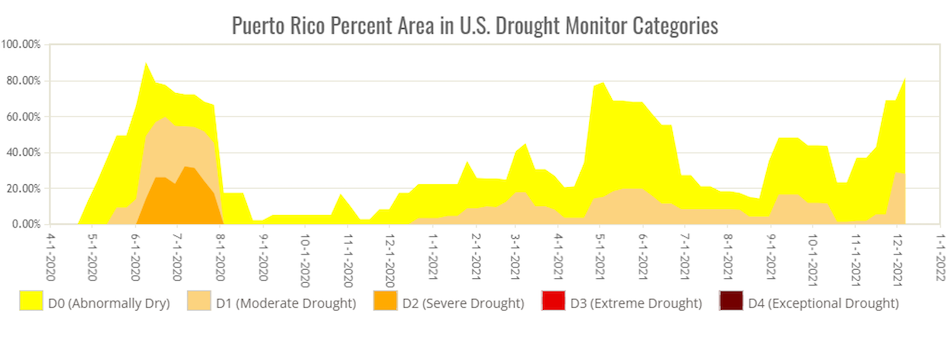
Rainfall Deficits
- 2021 Perspective: Although the western interior of Puerto Rico has received near- to above-normal rainfall throughout 2021, the rest of Puerto Rico and the U.S. Virgin Islands have been receiving below-normal rainfall.
- The year-to-date (YTD) rainfall deficits across the southern, central, and eastern interior of Puerto Rico range between 12 and 16 inches with higher amounts up to 20 inches (Figure 2). For the USVI, the YTD rainfall deficits range between 10 and 15 inches.
- At the primary climatological data sites, 2021 is likely to end as one of the 3 driest years on record at Henry E. Rohlsen Airport in Saint Croix (TISX) and a top 10 dry year at Cyril King Airport in St. Thomas (TIST). Year-to-date rainfall totals of 21.13 inches and 28.18 inches inches have been observed at TISX and TIST, which is 14.35 inches and 11.82 inches below normal, respectively.
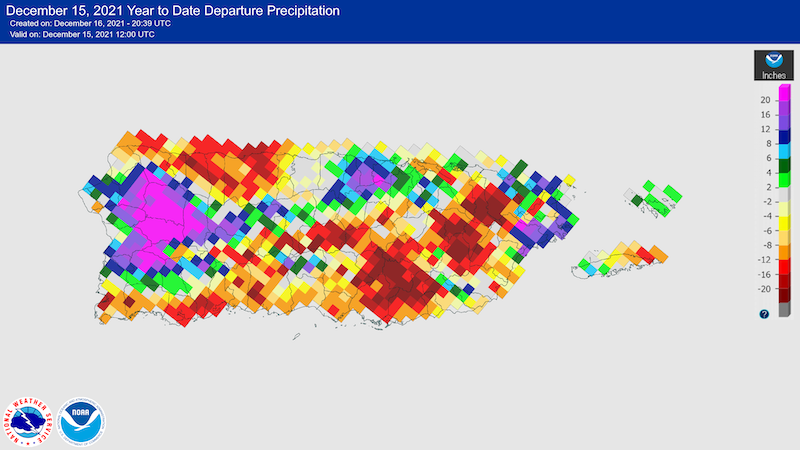
Soil Moisture Conditions in Puerto Rico
Soil moisture data from the Puerto Rico Agricultural Water Management (PRAGWATER) indicates very dry soils across the majority of Puerto Rico, except for a few spots across the eastern coastal areas of Puerto Rico and the western interior of the Island (Figures 3 and 4).
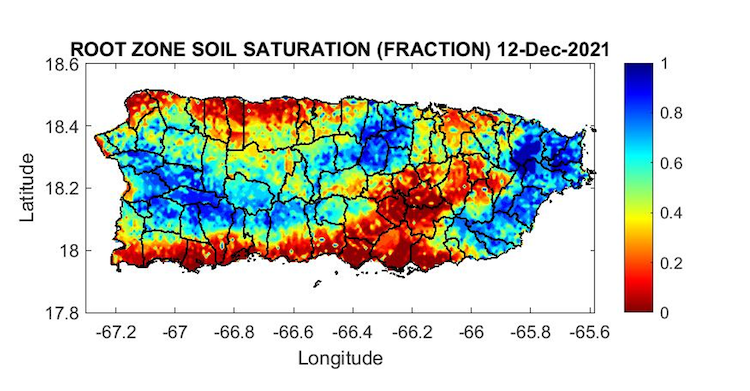
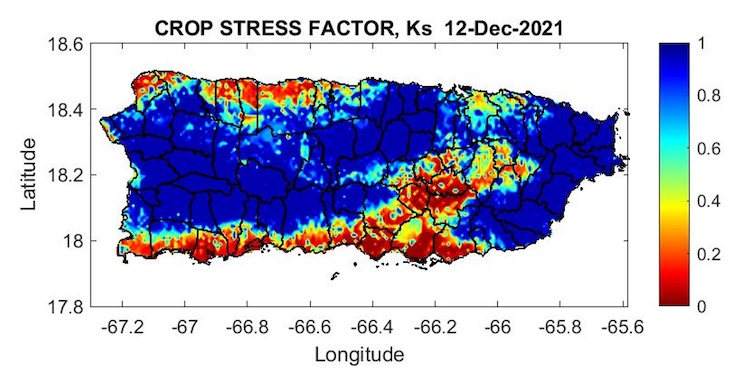
Streamflow Conditions in Puerto Rico
- The 28-day average streamflow measured by the U.S. Geological Survey (USGS) river gauge network indicates most of the streamflow across Puerto Rico running well below normal, with many of the sites having levels below the 10th percentile. There are no streamflow data for the U.S. Virgin Islands (Figure 5).
- Based on data provided by the Water Authority, a decreasing trend in the reservoir levels for water supply has been observed as well.
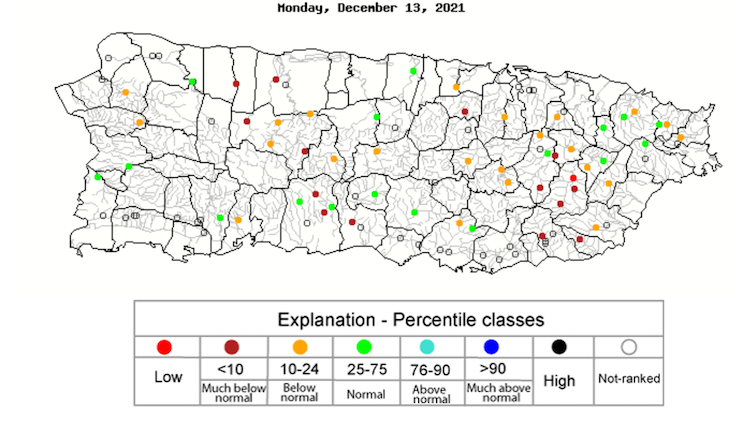
Groundwater Conditions
Groundwater levels retrieved from the U.S. Geological Survey network indicate a decreasing trend at the representative wells along southern Puerto Rico and across the U.S. Virgin Islands (Figure 6). Several wells across southern Puerto Rico are in critical conditions with values much below normal.
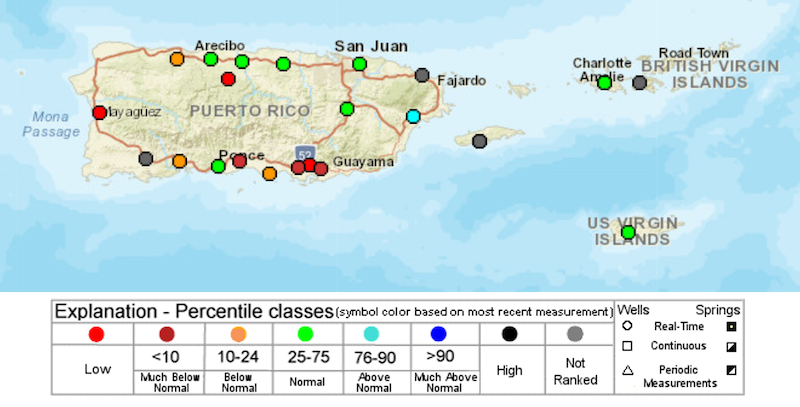
Outlooks and Impacts
Rainfall Outlook
Based on the 3-month extended forecast by the Caribbean Climate Outlook Forum (CariCOF), there are increased chances to observe below-normal rainfall through at least February 2022 (Figure 7).
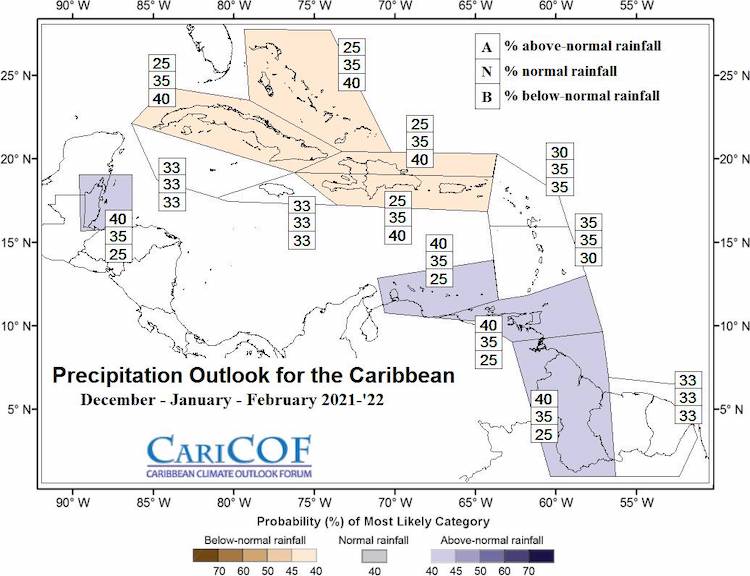
Sector Impacts
General Conditions
- Puerto Rico: Though the western interior of Puerto Rico has received significant rainfall, drought conditions throughout the rest of Puerto Rico are worsening. Dry conditions in the southern region are drying soils and vegetation, increasing the risk of wildfires. Elevated fire weather conditions are expected for the Southern Coastal Plains of Puerto Rico. Montane forests in the Central and Luquillo Mountains have not been noticeably affected by drought.
- U.S. Virgin Islands: All major islands in the USVI are drier than normal for this time of year. The wettest time of the year has normally passed by early December. Further, precipitation expectations are not being met at this time, which is concerning to many farmers as they store much of the water they use. Winds have severely impacted soil moisture, and some groundwater tables show a decrease in water availability. Both short- and long-term impacts are being observed.
Agricultural Conditions
Puerto Rico:
- December rains alleviated drought conditions for some agricultural operations in Puerto Rico, though the heavy rains following dry conditions in previous months have caused soil erosion and other issues for some. Still, agricultural operations in certain areas continue to struggle with drought and have adjusted their operations to cope with a lack of water and soil moisture.
- Two Puerto Rican farmers report that 2021 has been a dry year.
- A concerned and frustrated cattle rancher in Lajas (southwest) reports that 2021 has been the driest year he has experienced in his 42 years of cattle ranching. Due to dry pastures, he has been purchasing hay and feed to nourish his cattle for several months. The rancher shared that it is not cost-effective to buy feed, and there is concern that if dry conditions continue into 2022, he will not be able to continue operations. According to the rancher, there are about 18 ranchers in the region with a similar concern. Light rains in December quickly dried due to intense sun and wind. Although it has rained elsewhere in Lajas, the rancher reports that the area with cattle ranching activity is a pocket in Lajas where rainfall has been more scarce.
- In Villalba (central mountains), a farmer reports that there has been very little rain in 2021 in comparison with 2020. Conditions have been so unusually dry that the farmer reports that it has not been necessary to trim vegetation on farm roadways.
- Puerto Rican farmers also report drought or dry conditions on their farms in the last 2–3 months.
- In Santa Isabel (southeast), a farmer reports that the little rain that has fallen in December has not moistened the soil, and the land remains very dry after scarce rain in November and December.
- In Jayuya (central mountains), a farmer reports that their farm has been experiencing drought conditions for about 3 months, limiting their ability to apply the desired practices, such as fertilization.
- Meanwhile, farmers from several municipalities (the majority located in the central-north and north portions of the main island) report abundant rain in December, with some reporting very wet conditions on their farms. Many report that rain increased after a dry November (Morovis, Dorado, Vega Baja, Camuy, Hatillo, Juncos, Arecibo, San German, Corozal). However, farmers from two municipalities reported that November was rainy in their region as well (Toa Baja and Aguas Buenas).
- In Las Piedras, two months of rain following months of drought have resulted in soil erosion, loss of flowers on pea crops, and damage to “ñameras."
St. Thomas:
- Farmers report hot, dry weather with evaporation occurring rapidly after sporadic rainfall. The winds, which have been high, are also contributing to a lack of soil moisture. On St. Thomas, some agriculture ponds as well as private ponds are not full and have never filled completely back to capacity since 2015. Specialty and row crop farmers are reporting that lemon grass, kale, and peppers are burning due to heat; orchards—which require more water—are only being watered every other day to begin conservation methods required to carry out production through the Spring and Summer when water is in high demand.
St. John:
- Farmers are reporting that they are working harder, watering both early and late to continue with conservation methods. Soil is not retaining moisture, and farmers are already implementing immediate conservation methods including crop rotation and staggering watering schedules to maximize water resources. Farmers are also indicating that the need for increased irrigation and Smart Technology, which can help combat drought through increased data collection, helping to further their understanding of drought to increase production.
St. Croix:
- While some rain fell, farms of all sizes are reporting that hot, dry weather is still affecting the ability to retain soil moisture and collect water. One large producer reported purchasing 8,000 gallons of water per week to keep production on track. However, livestock farmers on St. Croix are not seeking to purchase feed as chop is available due to sporadic rain. Nevertheless, the long-term drought indicators are creating an underlying need for additional irrigation systems in the fields. Poultry farmers are reporting increased water in cisterns but decreased egg production. This is due to postal delays. Poultry farmers are also concerned that the lack of rainfall will impact production, which is not bouncing back following earlier episodes of extreme heat and drought and has had lasting effects throughout the year. The VI Department of Agriculture (VIDA) also reported that, on St. Croix, water deliveries to the agricultural community included more than 1,048,438 gallons in November. At the time of this publication, which is in mid-December, water deliveries were listed as 680,978 gallons. Since drought conditions continue overall, farmers are still planning mitigation efforts to rotate livestock to feed them.
For More Information
- National Weather Service (NWS) Weather Forecast Office – San Juan: Climate and Drought Information
- NWS Drought Information Statements for Puerto Rico and the U.S. Caribbean
- Drought.gov:
- Caribbean Drought Bulletins. Caribbean Regional Climate Center, Caribbean Institute for Meteorology and Hydrology (CIMH), Barbados
- U.S. Department of Agriculture (USDA) Caribbean Climate Hub drought and disaster assistance resources for tropical forestry and agriculture
Prepared By
Odalys Martinez
NWS Weather Forecast Office – San Juan
Meredith Muth
NOAA/National Integrated Drought Information System (NIDIS)
William Gould, Nora Álvarez-Berríos, and Eva Holupchinski
USDA Caribbean Climate Hub, USFS International Institute of Tropical Forestry
Christina Chanes, Gregory Guannel
University of the Virgin Islands
Victor Murphy
National Weather Service Southern Region
Brad Rippey
USDA Office of the Chief Economist
Héctor J. Jiménez
Office of Climatology, University of Puerto Rico
Puerto Rico Reporting Input: Thanks to the Agricultural Extension Service, College of Agricultural Sciences, University of Puerto Rico-Mayaguez. Thanks to Prof José L Zamora, Agricultural Extension Service, RUM-UPR, and Eric Harmsen, Professor of Agricultural Engineering UPR. Many thanks to the following agricultural professionals (farmers and ranchers) for your condition reporting: Miguel Carlo, Betzaida Ortiz-Carrion, Edna Albelo, Walker Franco, Norma Alvarez, Merna Morales, Tadilka, Maritere Juan, Patricia Piñero, Carmen Umpierre, Carmen Astrid Milagros Bonilla Quianes, Nilda Rivera, Zacha Muñiz Vera and Genoveva Lozada.
USVI Reporting Input: Several individuals contributed to this report and we are acknowledging the following for their support including the faculty, staff and collaborators of the UVI Physics Program, UVI Etelman Observatory, UVI Agricultural Experiment Station, VI Department of Agriculture, UVI Caribbean Green Technology Center, as well as the USDA Office Chief Economist, National Parks Service in St. Croix, USDA Farm Service Agency, Coral Bay Community Council and the many volunteers, drought reporters and farmers from across the territory.
About This Report
This drought update is issued in partnership between the National Integrated Drought Information System (NIDIS), National Oceanic and Atmospheric Administration (NOAA) National Weather Service, the U.S. Department of Agriculture (USDA), and the University of the Virgin Islands. The purpose of the update is to communicate a potential area of concern for drought expansion and/or development within Puerto Rico and the U.S. Virgin Islands based on recent conditions and the upcoming three-month forecast.
NIDIS and its partners will issue these updates every two months. Subscribe for these U.S. Caribbean drought updates here.





